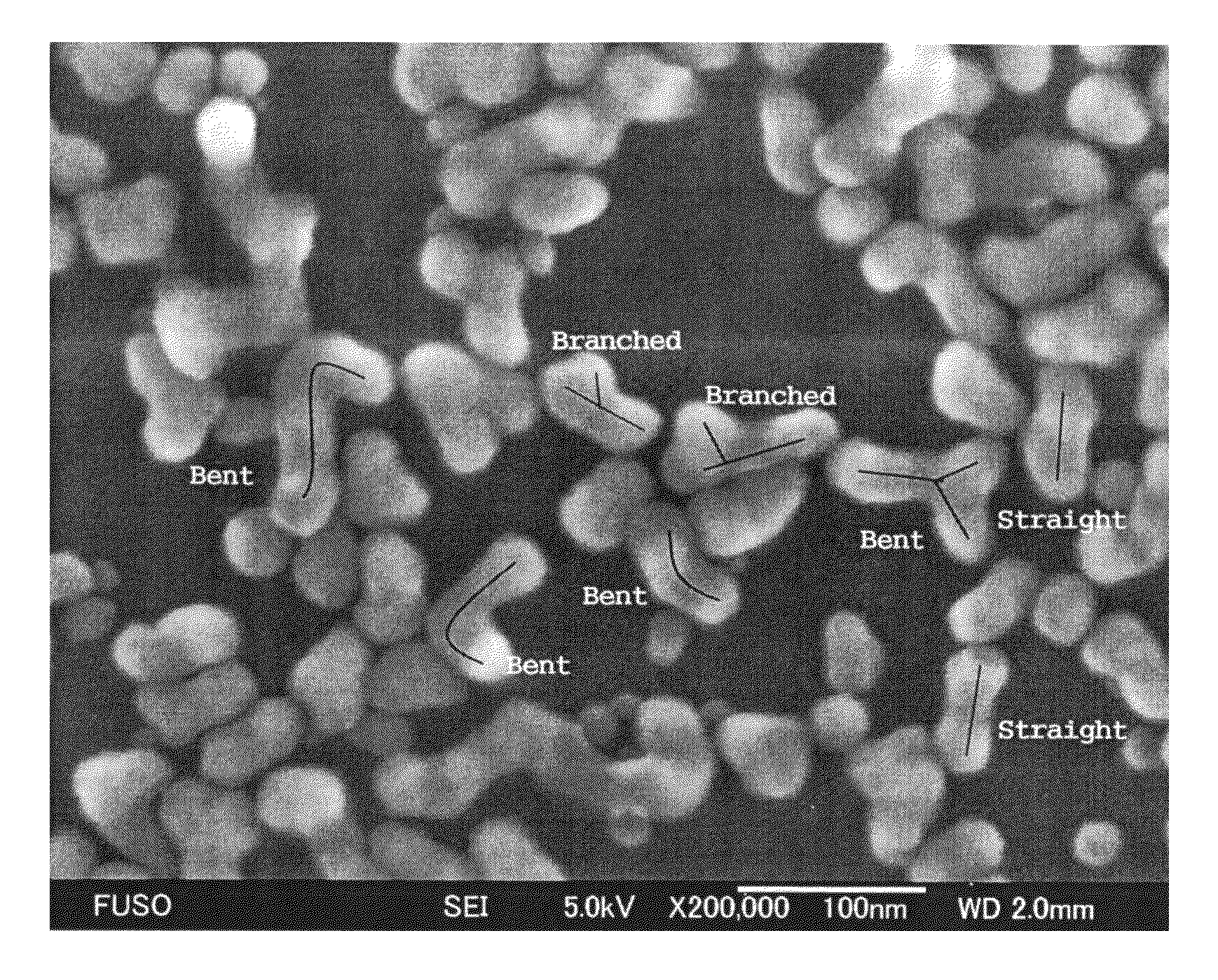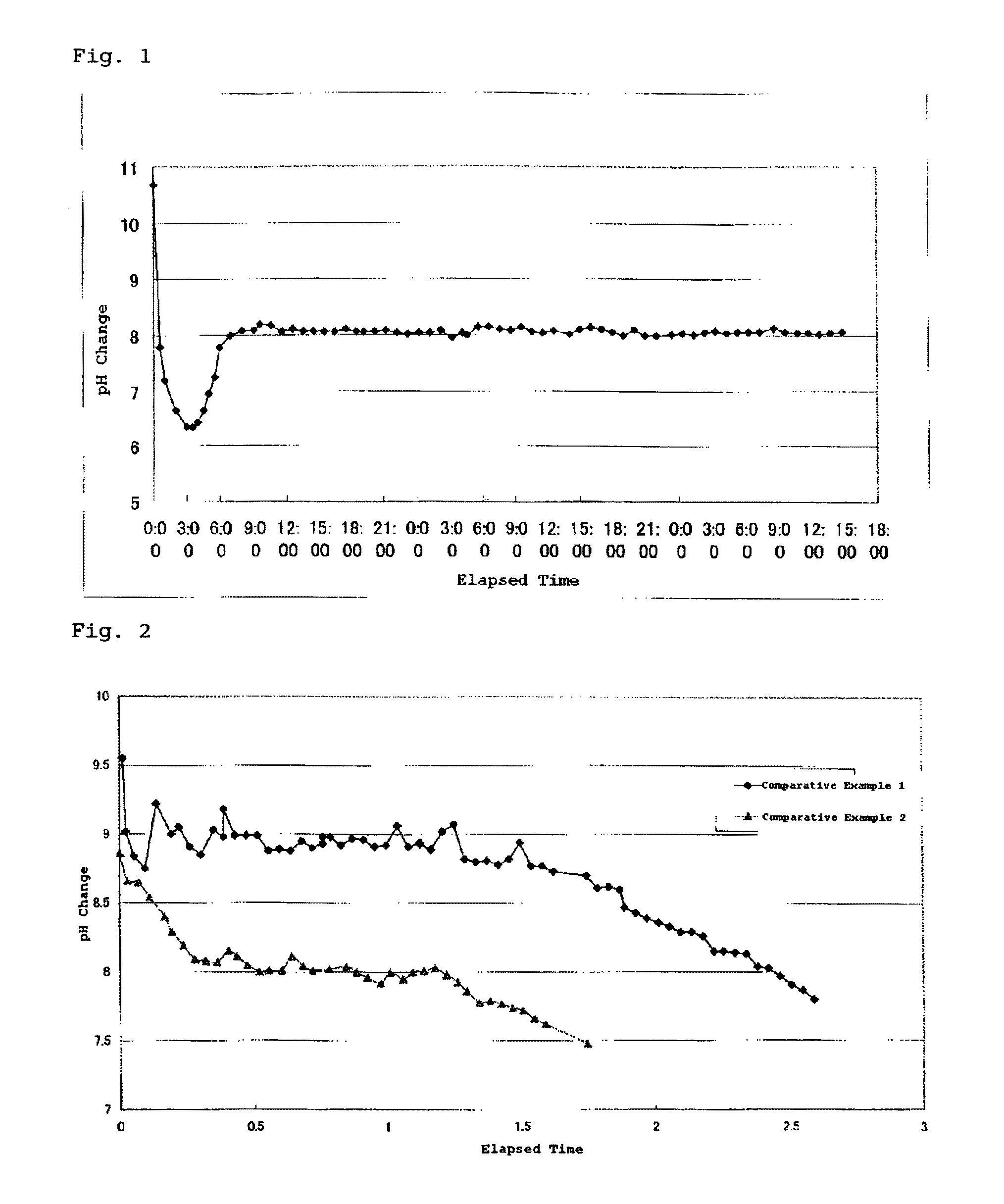Colloidal silica containing silica secondary particles having bent structure and/or branched structure, and method for producing same
a technology of colloidal silica and secondary particles, which is applied in the direction of silicon compounds, other chemical processes, silicon oxides, etc., can solve the problems of inability to obtain colloidal silica by such a method, inability to use colloidal silica in semiconductor manufacturing processes, and inability to achieve the effect of reducing the purity of colloidal silica, improving the polishing rate, and large aspect ratio
- Summary
- Abstract
- Description
- Claims
- Application Information
AI Technical Summary
Benefits of technology
Problems solved by technology
Method used
Image
Examples
example 1
[0116]228 g of tetramethyl orthosilicate (TMOS) was measured and transferred into an Erlenmeyer flask (volume: 3 L), to which 2,772 g of pure water was added at ordinary temperature with stirring. The obtained reaction liquid was opaque at the beginning, and, after 5 minutes, became transparent and homogeneous as the hydrolysis progressed. The reaction was continued as is for 1 hour, and a TMOS hydrolysis liquid having a silica content of 3 wt. % was thereby prepared. The pH of the hydrolysis liquid was about 4.4 due to the acidic silanol groups produced during the hydrolysis.
[0117]2,000 g of pure water and 2 g of 1N TMAH (tetramethyl ammonium hydroxide) were added into a four-necked flask (5 L) equipped with a feed tube, a stirrer, and a packed column (filled with 5 mm glass Raschig ring; filling height: 30 cm) provided with a thermometer and a reflux head, so as to yield a mother liquid. The pH of the mother liquid was 10.70. When the mother liquid was heated to reflux, feeding of...
example 2
[0132]228 g of tetramethyl orthosilicate (TMOS) was measured and transferred into an Erlenmeyer flask (volume: 3 L), to which 2,772 g of pure water was added at ordinary temperature with stirring. The obtained reaction liquid was opaque at the beginning, and, after 5 minutes, became transparent and homogeneous as the hydrolysis progressed. The reaction was continued as is for 1 hour, and a TMOS hydrolysis liquid having a silica content of 3 wt. % was thereby prepared. The pH of the hydrolysis liquid was about 4.4 due to the acidic silanol groups produced during the hydrolysis.
[0133]2,000 g of pure water and 2 g of 1N TMAH were added into a four-necked flask (5 L) equipped with a feed tube, a stirrer, and a packed column (filled with 5 mm glass Raschig rings; filling height: 30 cm) provided with a thermometer and a reflux head, so as to yield a mother liquid. The pH of the mother liquid was 10.65. When the mother liquid was heated to reflux, feeding of the TMOS hydrolysis liquid comm...
example 3
[0137]228 g of tetramethyl orthosilicate (TMOS) was measured and transferred into an Erlenmeyer flask (volume: 3 L), to which 2,772 g of pure water was added at ordinary temperature with stirring. The obtained reaction liquid was opaque at the beginning, and, after 5 minutes, became transparent and homogeneous as the hydrolysis progressed. The reaction was continued as is for 1 hour, and a TMOS hydrolysis liquid having a silica content of 3 wt. % was thereby prepared. The pH of the hydrolysis liquid was about 4.4 due to the acidic silanol groups produced during the hydrolysis.
[0138]2,000 g of pure water and 2 g of 1N TMAH were added into a four-necked flask (5 L) equipped with a feed tube, a stirrer, and a packed column (filled with 5 mm glass Raschig rings; filling height: 30 cm) provided with a thermometer and a reflux head, so as to yield a mother liquid. When the mother liquid was heated to reflux, feeding of the TMOS hydrolysis liquid commenced. The addition rate was 16 mL / minu...
PUM
| Property | Measurement | Unit |
|---|---|---|
| average aspect ratio | aaaaa | aaaaa |
| average aspect ratio | aaaaa | aaaaa |
| pH | aaaaa | aaaaa |
Abstract
Description
Claims
Application Information
 Login to View More
Login to View More - R&D
- Intellectual Property
- Life Sciences
- Materials
- Tech Scout
- Unparalleled Data Quality
- Higher Quality Content
- 60% Fewer Hallucinations
Browse by: Latest US Patents, China's latest patents, Technical Efficacy Thesaurus, Application Domain, Technology Topic, Popular Technical Reports.
© 2025 PatSnap. All rights reserved.Legal|Privacy policy|Modern Slavery Act Transparency Statement|Sitemap|About US| Contact US: help@patsnap.com



